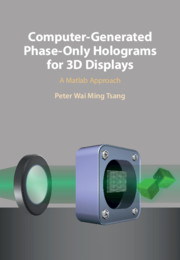Book contents
- Computer-Generated Phase-Only Holograms for 3D Displays
- Computer-Generated Phase-Only Holograms for 3D Displays
- Copyright page
- Contents
- Preface
- Acknowledgments
- 1 Introduction to Digital Holography
- 2 Fast Methods for Computer-Generated Holography
- 3 Generation of Phase-Only Fresnel Hologram
- 4 Conversion of Complex-Valued Holograms to Phase-Only Holograms
- 5 Applications of Phase-Only Hologram in Display, Holographic Encryption, and Steganography
- Index
- References
5 - Applications of Phase-Only Hologram in Display, Holographic Encryption, and Steganography
Published online by Cambridge University Press: 07 January 2021
- Computer-Generated Phase-Only Holograms for 3D Displays
- Computer-Generated Phase-Only Holograms for 3D Displays
- Copyright page
- Contents
- Preface
- Acknowledgments
- 1 Introduction to Digital Holography
- 2 Fast Methods for Computer-Generated Holography
- 3 Generation of Phase-Only Fresnel Hologram
- 4 Conversion of Complex-Valued Holograms to Phase-Only Holograms
- 5 Applications of Phase-Only Hologram in Display, Holographic Encryption, and Steganography
- Index
- References
Summary
Digital holography has indeed led to numerous advancement of the classical, analog holographic technology that only permits a hologram to be permanently recorded onto a photographic film. In digital holography, a hologram can be captured from a real object. It can also be numerically generated as an array of numbers that can be stored as digital data, processed through computation, and distributed via digital communication links. In general, the primary purpose of holograms is to display 3-D images. Hence, a digital hologram in digital data form will not be of much practical use if it cannot be visually seen as a 3-D image. This is one of the major disadvantages of a digital hologram compared with the optical hologram, which can be readily captured with our eyes. However, a digital hologram can have different applications apart from generating 3-D images. In fact, recent research has shown that a digital hologram can be utilized in protecting sensitive data (a task referred to as cryptography), or in steganography for embedding large amount of additional data. This chapter describes some of the important applications of digital phase-only holograms in 3-D display, holographic cryptography, and steganography.
Keywords
- Type
- Chapter
- Information
- Computer-Generated Phase-Only Holograms for 3D DisplaysA Matlab Approach, pp. 147 - 193Publisher: Cambridge University PressPrint publication year: 2021



